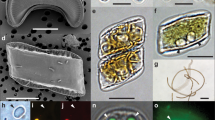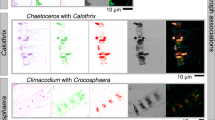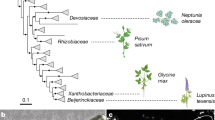Abstract
Biological nitrogen fixation has been suggested as an important source of nitrogen for the ultra-oligotrophic waters of the Levantine Basin of the Mediterranean Sea. In this study, we identify and characterize the spatial and temporal distribution of the N-fixing (diazotrophic) cyanobacterium Richelia intracellularis. R. intracellularis is usually found as an endosymbiont within diatoms such as Rhizosolenia spp and Hemiaulus spp. and is an important diazotroph in marine tropical oceans. In this study, two stations off the Mediterranean coast of Israel were sampled monthly during 2005–2007. R. intracellularis was identified by microscopy and by reverse transcribed-PCR which confirmed a 98.8% identity with known nifH sequences of R. intracellularis from around the world. The diatom–diazotroph associations were found throughout the year peaking during autumn (October–November) at both stations. Abundance of R. intracellularis ranged from 10 to 55 heterocysts l−1 and correlated positively with the dissolved Si(OH)4/(NO3+NO2) ratio in surface waters. Although the rates of nitrogen fixation were very low, averaging ∼1.1 nmol N l−1 day−1 for the R. intracellularis size fraction (>10 μm) from surface waters, they correlated positively with heterocyst counts during thermal stratification. The lack of large-scale diatom–diazotroph blooms and the low rates of nitrogen fixation by these diazotrophs may result from the P-starved conditions affecting the Levantine basin.
Similar content being viewed by others
Log in or create a free account to read this content
Gain free access to this article, as well as selected content from this journal and more on nature.com
or
References
Allen MM, Morris R, Zimmerman W . (1984). Cyanophycin granule polypeptide protease in a unicellular cyanobacterium. Arch Microbiol 138: 119–123.
Arrigo KR . (2005). Marine microorganisms and global nutrient cycles. Nature 438: 122.
Azov Y . (1986). Seasonal patterns of phytoplankton productivity and abundance in near shore oligotrophic waters of the Levant basin (Mediterranean). J Plankton Res 8: 41–53.
Berman T, Townsend DW, Elsayed SZ, Trees CC, Azov Y . (1984). Optical transparency, chlorophyll and primary productivity in the Eastern Mediterranean near the Israeli coast. Oceanologica Acta 7: 367–372.
Bethoux BJP . (1986). Biological fixation of atmospheric nitrogen in the Mediterranean Sea. Limnology and Oceanography 31: 1353–1358.
Bethoux JP, de Madron XD, Nyffeler F, Tailliez D . (2002). Deep water in the Western Mediterranean: Peculiar 1999 and 2000 characteristics, shelf formation hypothesis, variability since 1970 and geochemical inferences. J Mar Syst 33: 117–131.
Bethoux JP, Morin P, Chaumery C, Connan O, Gentili B, Ruiz-Pino D . (1998). Nutrients in the Mediterranean Sea, mass balance and statistical analysis of concentrations with respect to environmental change. Mar Chem 63: 155–169.
Bethoux JP, Morin P, Madec C, Gentili B . (1992). Phosphorus and nitrogen behavior in the Mediterranean-Sea. Deep-Sea Research Part I-Oceanographic Research Papers 39: 1641–1654.
Bonin DJ, Bonin MC, Berman T . (1989). Experimental-evidence of nutrients limiting the production of micronanoplankton and ultraplankton in the coastal waters of the Eastern Mediterranean Ocean (Haifa, Israel). Aquat Sci 51: 129–152.
Capone DG . (1993). Determination of nitrogenase activity in aquatic samples using the acetylene reduction procedure. In: Kemp PF, Sherr B, Sherr E, Cole J (eds). Handbook of Methods in Aquatic Microbial Ecology. pp 621–631.
Capone DG, Montoya JP . (2001). Nitrogen fixation and denitrification. Methods Microbiol 30: 501–515.
Capone DG, Zehr JP, Paerl HW, Bergman B, Carpenter EJ . (1997). Trichodesmium, a globally significant marine cyanobacterium. Science 276: 1221–1229.
Carpenter EJ, Montoya JP, Burns J, Mulholland MR, Subramaniam A, Capone DG . (1999). Extensive bloom of a N2-fixing diatom/cyanobacterial association in the tropical Atlantic Ocean. Mar Ecol-Prog Ser 185: 273–283.
Carpenter EJ, Romans K . (1991). Major role of the cyanobacterium Trichodesmium in nutrient cycling in the North-Atlantic Ocean. Science 254: 1356–1358.
Deutsch C, Sarmiento JL, Sigman DM, Gruber N, Dunne JP . (2007). Spatial coupling of nitrogen inputs and losses in the ocean. Nature 445: 163–167.
Falcon LI, Carpenter EJ, Cipriano F, Bergman B, Capone DG . (2004). N2 fixation by unicellular bacterioplankton from the Western and Pacific Oceans: Phylogeny and in situ rates. Appl Environ Microbiol 70: 765–770.
Falcon LI, Cipriano F, Chistoserdov AY, Carpenter EJ . (2002). Diversity of diazotrophic unicellular cyanobacteria in the tropical North Atlantic Ocean. Appl Environ Microbiol 68: 5760–5764.
Fay P . (1992). Oxygen relations of nitrogen-fixation in cyanobacteria. Microbiol Rev 56: 340–373.
Flaten GAF, Skjoldal EF, Krom MD, Law CS, Mantoura RFC, Pitta P et al. (2005). Studies of the microbial P-cycle during a lagrangian phosphate-addition experiment in the Eastern Mediterranean. Deep-Sea Research Part II-Topical Studies in Oceanography 52: 2928–2943.
Foster RA, O'Mullen GD . (In press). Nitrogen-fixing and nitrifying symbioses in the marine environment. In: Capone, DG, Bronk D, Mulholland MR, Carpenter EJ (eds). Nitrogen in the Marine Environment. Academic Press/Elsevier: San Diego.
Foster RA, Subramaniam A, Mahaffey C, Carpenter EJ, Capone DG, Zehr JP . (2007). Influence of the Amazon river plume on distributions of free-living and symbiotic cyanobacteria in the Western tropical North Atlantic ocean. Limnol Oceanography 52: 517–532.
Garcia N, Raimbault P, Gouze E, Sandroni V . (2006). Nitrogen fixation and primary production in Western Mediterranean. Comptes Rendus Biologies 329: 742–750.
Geitler L . (1932). Cyanophyceae. In: Rabenhorst L. (ed). Rabenhorst's Kryptogamen-Flora von Deutchland, Österreich und der Schweiz, vol. 14. Akademische Verlagsgesellschaft, Leipzig. pp 1–1196.
Gomez F, Furuya K, Takeda S . (2005). Distribution of the cyanobacterium Richelia intracellularis as an epiphyte of the diatom Chaetoceros compressus in the Western Pacific Ocean. J Plankton Res 27: 323–330.
Guerzoni S, Chester R, Dulac F, Herut B, Loye-Pilot MD, Measures C et al. (1999). The role of atmospheric deposition in the biogeochemistry of the Mediterranean Sea. Prog Oceanography 44: 147–190.
Heinbokel J . (1986). Occurrence of Richelia intracellularis (cyanophyta) within the diatoms Hemiaulus Haukii and H. Membranaceus off Hawaii. J Phycol 22: 399–403.
Herut B, Collier R, Krom MD . (2002). The role of dust in supplying nitrogen and phosphorus to the Southeast Mediterranean. Limnol Oceanography 47: 870–878.
Herut B, Zohary T, Krom MD, Mantoura RFC, Pitta P, Psarra S et al. (2005). Response of East Mediterranean surface water to Saharan dust: on-board microcosm experiment and field observations. Deep-Sea Research Part II-Topical Studies in Oceanography 52: 3024–3040.
Herut B, Zohary T, Robarts RD, Kress N . (1999). Adsorption of dissolved phosphate onto loess particles in surface and deep Eastern Mediterranean water. Mar Chem 64: 253–265.
Horner-Devine MC, Carney KM, Bohannan BJM . (2004a). An ecological perspective on bacterial biodiversity. Proc R Soc Lond Ser B 271: 113–122.
Horner-Devine MC, Lage M, Hughes JB, Bohannan BJM . (2004b). A taxa–area relationship for bacteria. Nature 432: 750–753.
Ignatiades L, Psarra S, Zervakis V, Pagou K, Souvermezoglou E, Assimakopoulou G et al. (2002). Phytoplankton size-based dynamics in the Aegean Sea (Eastern Mediterranean). J Mar Syst 36: 11–28.
Jahnke LL, Summons RE, Hope JM, des Marais DJ . (1999). Carbon isotopic fractionation in lipids from methanotrophic bacteria II: The effects of physiology and environmental parameters on the biosynthesis and isotopic signatures of biomarkers. Geochimica Et Cosmochimica Acta 63: 79–93.
Janson S, Carpenter EJ, Bergman B . (1995a). Immunolabeling of phycoerythrin, ribulose 1,5-bisphosphate carboxylase oxygenase and nitrogenase in the unicellular cyanobionts of Ornithocercus spp (dinophyceae). Phycologia 34: 171–176.
Janson S, Rai AN, Bergman B . (1995b). Intracellular cyanobiont Richelia-intracellularis—ultrastructure and immuno-localization of phycoerythrin, nitrogenase, rubisco and glutamine-synthetase. Mar Biol 124: 1–8.
Janson S, Wouters J, Bergman B, Carpenter EJ . (1999). Host specificity in the Richelia–diatom symbiosis revealed by hetR gene sequence analysis. Environ Microbiol 1: 431–438.
Kemp AES, Pearce RB, Koizumi I, Pike J, Rance SJ . (1999). The role of mat-forming diatoms in formation of Mediterranean sapropels. Nature 398: 57–61.
Kimor B, Berman T, Schneller A . (1987). Phytoplankton assemblages in the deep chlorophyll maximum layers off the Mediterranean coast of Israel. J Plankton Res 9: 433–443.
Kimor B, Gordon N, Neori A . (1992). Symbiotic associations among the microplankton in oligotrophic marine environments, with special reference to the Gulf of Aqaba, Red Sea. J Plankton Res 14: 1217–1231.
Kress N, Thingstad TF, Pitta P, Psarra S, Tanaka T, Zohary T et al. (2005). Effect of P and nN addition to oligotrophic Eastern Mediterranean waters influenced by near-shore waters: a microcosm experiment. Deep-Sea Research Part II-Topical Studies in Oceanography 52: 3054–3073.
Krom MD, Woodward EMS, Herut B, Kress N, Carbo P, Mantoura RFC et al. (2005). Nutrient cycling in the south East Levantine basin of the Eastern Mediterranean: results from a phosphorus starved system. Deep-Sea Research Part II-Topical Studies in Oceanography 52: 2879–2896.
Kromkamp J . (1987). Formation and functional significance of storage products in cyanobacteria. New Zealand J Mar Freshwater Res 21: 457–465.
Li WKW, Zohary T, Yacobi YZ, Wood AM . (1993). Ultraphytoplankton in the Eastern Mediterranean-Sea—towards deriving phytoplankton biomass from flow cytometric measurements of abundance, fluorescence and light scatter. Mar Ecol-Prog Ser 102: 79–87.
Mague TH, Mague FC, Holmhansen O . (1977). Physiology and chemical composition of nitrogen-fixing phytoplankton in central North Pacific Ocean. Mar Biol 41: 213–227.
Man-Aharonovich D, Kress N, Bar Zeev E, Berman-Frank I, Beja O . (2007). Molecular ecology of nifH genes and transcripts in the Eastern Mediterranean Sea. Environ Microbiol 9: 2354–2363.
Massana R, Murray A, Preston C, DeLong E . (1997). Vertical distribution and phylogenetic characterization of marine planktonic archaea in the Santa Barbara channel. Appl Environ Microbiol 63: 50–56.
Montoya JP, Holl CM, Zehr JP, Hansen A, Villareal TA, Capone DG . (2004). High rates of N2 fixation by unicellular diazotrophs in the oligotrophic Pacific Ocean. Nature 430: 1027–1031.
Pantoja S, Repeta DJ, Sachs JP, Sigman DM . (2002). Stable isotope constraints on the nitrogen cycle of the Mediterranean Sea water column. Deep-Sea Research Part I-Oceanographic Research Papers 49: 1609–1621.
Peterson RB, Dolan E, Calvert HE, Ke B . (1981). Energy transfer from phycobiliproteins to photosystem I in vegetative cells and heterocysts of anabaena variabilis. Biochim Biophys Acta 12: 237–248.
Psarra S, Tselepides A, Ignatiades L . (2000). Primary productivity in the oligotrophic Cretan Sea (NE Mediterranean): seasonal and interannual variability. Prog Oceanography 46: 187–204.
Psarra S, Zohary T, Krom MD, Mantoura RFC, Polychronaki T, Stambler N et al. (2005). Phytoplankton response to a lagrangian phosphate addition in the Levantine Sea (Eastern Mediterranean). Deep-Sea Research Part II-Topical Studies in Oceanography 52: 2944–2960.
Rai AN, Soderback E, Bergman B . (2000). Cyanobacterium-plant symbioses. New Phytologist 147: 449–481.
Rees AP, Law CS, Woodward EMS . (2006). High rates of nitrogen fixation during an in-situ phosphate release experiment in the Eastern Mediterranean Sea. J Geophysical Res Lett 33: L10607, doi:10.1029/2006GL025791.
Rosentraub Z, Brenner S . (2007). Circulation over the southeastern continental shelf and slope of the Mediterranean Sea: direct current measurements, winds, and numerical model simulations. J Geophys Res 112: C11001, doi:10.1029/2006JC003775.
Sachs JP, Repeta DJ . (1999). Oligotrophy and nitrogen fixation during Eastern Mediterranean sapropel events. Science 286: 2485–2488.
Sundstrom BG . (1984). Observations on Rhizosolenia-clevei ostenfeld (bacillariophyceae) and Richelia-intracellularis schmidt (cyanophyceae). Botanica Marina 27: 345–355.
Swofford DL . (2002). Paup*. Phylogenetic Analysis using Parsimony. Sinauer Associates: Sunderland, MA, USA.
Tanaka T, Zohary T, Krom MD, Law SC, Pitta P, Psarra S et al. (2007). Microbial community structure and function in the Levantine basin of the Eastern Mediterranean. Deep-Sea Research Part I-Oceanographic Research Papers 54: 1721–1743.
Taylor FJR . (1982). Symbioses in marine microplankton. Annales De L Institut Oceanographique 58: 61–90.
Thingstad TF, Krom MD, Mantoura RFC, Flaten GAF, Groom S, Herut B et al. (2005). Nature of phosphorus limitation in the ultraoligotrophic Eastern Mediterranean. Science 309: 1068–1071.
Thompson JD, Gibson TJ, Plewniak F, Jeanmougin F, Higgins DG . (1997). The CLUSTAL-X Windows interface: flexible strategies for multiple sequence alignment aided by quality analysis tools. Nucleic Acids Res 25: 4876–4882.
Turelli M, Barton NH, Coyne JA . (2001). Theory and speciation. Trends Ecol Evolution 16: 330–343.
Venrick EL . (1974). Distribution and significance of Richelia-intracellularis schmidt in North Pacific central gyre. Limnol Oceanography 19: 437–445.
Vidussi F, Claustre H, Manca BB, Luchetta A, Marty JC . (2001). Phytoplankton pigment distribution in relation to upper thermocline circulation in the Eastern Mediterranean Sea during winter. J Geophysical Res-Oceans 106: 19939–19956.
Villareal T . (1994). Widespread occurrence of the Hemiaulus-cyanobacterial symbiosis in the Southwest North Atlantic Ocean. Bull Mar Sci 54: 1–7.
Villareal TA . (1989). Division cycles in the nitrogen-fixing Rhizosolenia (bacillariophyceae) Richelia (nostocaceae) symbiosis. Br Phycol J 24: 357–365.
Villareal TA . (1991). Nitrogen-fixation by the cyanobacterial symbiont of the diatom genus Hemiaulus. Mar Ecol-Prog Ser 76: 201–204.
Villareal TA . (1992). Buoyancy properties of the giant diatom Eethmodiscus. J Plankton Res 14: 459–463.
Wingard LL, Miller SR, Sellker JM, Stenn E, Allen MM, Wood AM . (2002). Cyanophycin production in a phycoerythrin-containing marine Synechococcus strain of unusual phylogenetic affinity. Appl Environ Microbiol 68: 1772–1777.
Wolk CP, Ernst A, Elhai J . (1994). Heterocyst metabolism and development. In: Bryant DA (ed). The Molecular Biology of Cyanobacteria. Dordrecht, Kluwer Academic Publishers: the Netherlands. pp 769–823.
Wyman M, Gregory RPF, Carr NG . (1985). Novel role for phycoerythrin in a marine cyanobacterium, Synechococcus strain DC2. Science 230: 818–820.
Yacobi YZ, Zohary T, Kress N, Hecht A, Robarts RD, Waiser M et al. (1995). Chlorophyll distribution throughout the Southeastern Mediterranean in relation to the physical structure of the water mass. J Mar Syst 6: 179–190.
Zani S, Mellon MT, Collier JL, Zehr JP . (2000). Expression of nifH genes in natural microbial assemblages in Lake George, New York, detected by reverse transcriptase PCR. Appl Environ Microbiol 66: 3119–3124.
Zehr JP, Bench SR, Mondragon EA, McCarren J, DeLong EF . (2007). Low genomic diversity in tropical oceanic N2-fixing cyanobacteria. Proc Natl Acad Sci 104: 17807–17812.
Zehr JP, McReynolds LA . (1989). Use of degenerate oligonucleotides for amplification of the nifH gene from the marine cyanobacterium Trichodesmium thiebautii. Appl Environ Microbiol 55: 2522–2526.
Zehr JP, Waterbury JB, Turner PJ, Montoya JP, Omoregie E, Steward GF et al. (2001). Unicellular cyanobacteria fix N2 in the subtropical North Pacific Ocean. Nature 412: 635–638.
Zhang C-C, Laurent S, Sakr S, Peng L, Bédu S . (2006). Heterocyst differentiation and pattern formation in cyanobacteria: a chorus of signals. Mol Microbiol 59: 367–375.
Zohary T, Herut B, Krom MD, Mantoura RFC, Pitta P, Psarra S et al. (2005). P-limited bacteria but N and P co-limited phytoplankton in the Eastern Mediterranean—a microcosm experiment. Deep-Sea Research Part II-Topical Studies in Oceanography 52: 3011–3023.
Acknowledgements
We thank the Captain (Dani Sheffer) and Engineer (Etai Catzman) of the R/V Mediterranean Explorer and the EcoOcean Marine Research and Education Organization as well as the captain and crew of the R/V Shikmona for their expert assistance at sea. The R/V Shikmona cruises were funded by a donation of the Israel Oceanographic and Limnological Research North American Friends. Many thanks to R Foster for bringing to our attention the importance of the diatom–diazotroph symbioses as well as for insightful suggestions, tips, and much help throughout. Thanks to B Kimor, E Carpenter, and N Gordon for aid in identification of the diatom–diazotrophs and to E Rahav for technical help at sea. We thank I Gertman from IOLR for generating Figure 1. This research is part of the requirements for an MSc thesis for EB-Z and for a Ph D thesis for TY at Bar Ilan University. This study is supported by an Israel Science Foundation Grant (No. 458/04) to IB-F and OB.
Author information
Authors and Affiliations
Corresponding author
Rights and permissions
About this article
Cite this article
Zeev, E., Yogev, T., Man-Aharonovich, D. et al. Seasonal dynamics of the endosymbiotic, nitrogen-fixing cyanobacterium Richelia intracellularis in the eastern Mediterranean Sea. ISME J 2, 911–923 (2008). https://doi.org/10.1038/ismej.2008.56
Received:
Revised:
Accepted:
Published:
Issue date:
DOI: https://doi.org/10.1038/ismej.2008.56
Keywords
This article is cited by
-
Seasonality and latitudinal variability in the diatom-cyanobacteria symbiotic relationships in the coastal waters of the Red Sea, Saudi Arabia
Symbiosis (2019)
-
Contribution of mono and polysaccharides to heterotrophic N2 fixation at the eastern Mediterranean coastline
Scientific Reports (2016)
-
Emerging patterns of marine nitrogen fixation
Nature Reviews Microbiology (2011)
-
Diversity of active marine picoeukaryotes in the Eastern Mediterranean Sea unveiled using photosystem-II psbA transcripts
The ISME Journal (2010)
-
Unicellular cyanobacteria with a new mode of life: the lack of photosynthetic oxygen evolution allows nitrogen fixation to proceed
Archives of Microbiology (2010)



